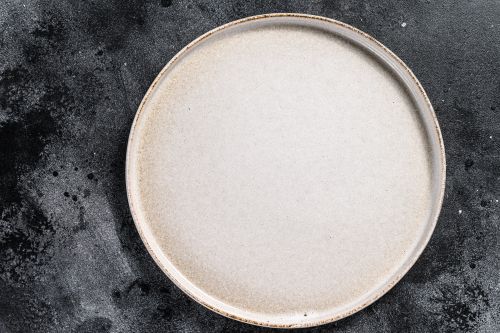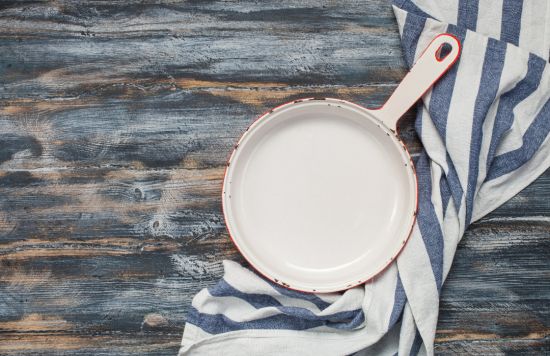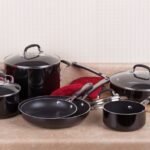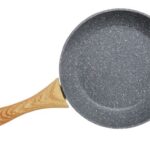What Is Enameled Cookware Made of?
Enamel cookware is popular because of its beautiful appearance and easy cleaning. Additionally, enameled cookware is an ideal choice for people looking for non-reactive cooking vessels for their kitchen.
Enamelware is made by fusing a layer of glass with metal at very high temperatures to create a smooth, non-porous surface. The inner core can be made of cast iron, steel, or aluminum. The glass-like coating protects the metal surface from corrosion, makes cleaning easier, and prevents the metal base from reacting with food. Due to strict FDA regulations, enameled cookware is safe for food preparation and ensures that the coating does not contain any substances harmful to health.

Is Scratched Enamel Cookware Safe?
If the damage to your enamelware is due to dark stains from metal utensils and the enamel coating has not been damaged and removed, you can clean the cookware and use it to cook your meals. Dark marks left by metal utensils are defects that can be removed by cleaning. Simply add some lemon to the baking soda to make a paste, gently rub the surface with a non-abrasive sponge, then rinse with warm water
You can also remove knife marks with Bar Keepers Friend powder cleaner and a non-abrasive sponge.
To avoid damaging the enamel layer, use non-metallic utensils, such as silicone, wood, or bamboo. Also, allow your enamel cookware to cool gradually.

Is Chipped Enamel Cookware Safe?
Enamel coating can chip if dropped or exposed to a hard object, revealing the metal underneath. This impairs the functionality of the cookware, as harmful ingredients can get into the food through the unprotected metal core.
Another potential problem is small, sharp enamel particles that can get into food and cause mouth and throat injuries.
Finally, chipped enamel has a rough surface that is not easy to keep clean and can harbor germs and bacteria.

How Does Chipped Coating Affect the Functionality of Enameled Cookware?
Enameled cast iron cookware: If the enamel coating of the cooking surface is damaged, the iron molecules from the metal core will leak into your food. There are some opinions that a certain amount of iron leakage could be beneficial for people with iron deficiency. However, determining the correct iron dose in this way is not easy and should be avoided. Excess iron in the body acts the opposite of an antioxidant and can cause cell damage and serious health problems, including damage to the brain and liver. To avoid these problems, you should not try to add extra iron to your body by using iron cookware. Discard enameled cast iron cookware with chipped enamel or stop using it for cooking and serving food.
Enamel on steel cookware: The inside of this cookware is made of carbon steel or stainless steel and is coated with a thin layer of glass. While carbon steel or stainless steel cookware can be reactive when cooking or storing foods with acidic ingredients, enamel on steel cookware is safe for preparing any type of food.
A glass-like coating may chip, or crack like any other enamelware. If the base is made of nonreactive steel, chipped items won’t leak metals into your food. Note that reactive steel can be susceptible to rust and reactions with food.
To be on the safe side, discard pieces with chipped enamel coating as the damaged area will continue to chip and may be difficult to keep clean.
Enameled Aluminum Cookware: Modern enameled aluminum cookware has a cast aluminum core and an enamel coating. Aluminum is an excellent heat conductor, while the enamel coating ensures cookware is as elegant and easy to maintain. The cast aluminum core makes this cookware much lighter than enameled cast iron cookware.
Although there is no accepted evidence that aluminum is unsafe, aluminum can cause some harmful side effects, especially in people with impaired kidney function.
To minimize the risk of aluminum-related health problems, discard cooking vessels with chipped or cracked enamel or do not use them to prepare food.
Is It Possible to Repair Chipped Enamel Cookware?
If your cookware is relatively new, check with your cookware manufacturer to make sure the damage was not your fault. The company may replace the damaged cookware with a new one.
Enamel repair kits allow you to repair exterior enamel surfaces that do not come into contact with food. If you attempt to repair enameled cookware, the repaired cooking surface will no longer be food-safe.
Is Vintage Enamelware Safe to Use in the Kitchen?
Although enameled cookware came to the US in the mid-19th century, the FDA began regulating lead levels in the 1970s to ensure that enameled cookware was safe for food contact. In the past, some manufacturers used additives such as lead and cadmium when producing colorful enamelware.
Because enameled dishes manufactured before 1970 are not subject to lead content regulations, you should not use them for cooking and storing food as they may contain high levels of toxic metals such as lead and cadmium.
It is also possible for pieces made around 1970 to have a very thin layer of enamel that is prone to chipping.
Before using old enameled cookware, you need to check it for cracks and chips. You also need to know the manufacturing process and the exact year the item was made.
Because vintage enamelware can look very attractive and rustic, many pieces from earlier eras may have value for serious collectors.
If you have vintage enamel dishes, you can decorate your kitchen by placing them on your shelves or using them as a beautiful vase for freshly picked flowers.




